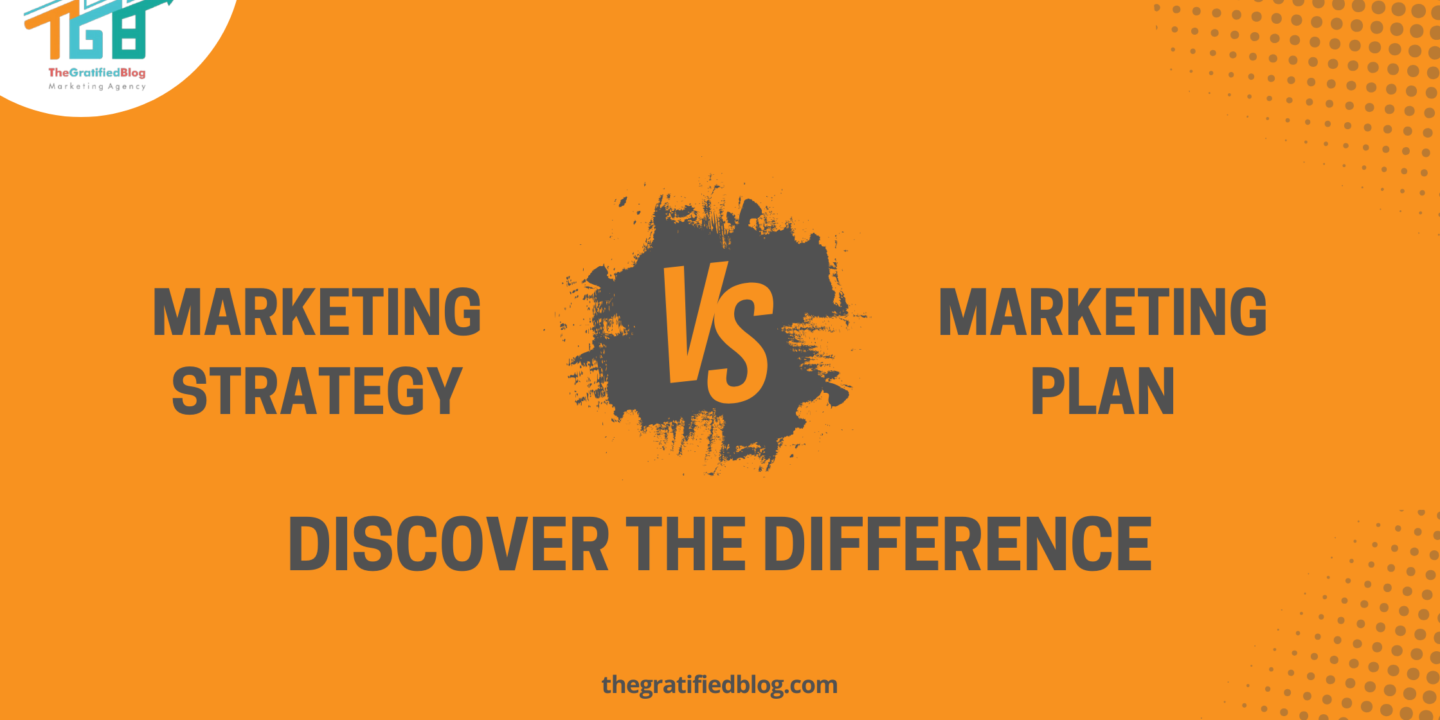
In dynamic marketing, two terms often intermingle but hold distinct significance: marketing strategy and marketing plan. Understanding the nuances between these concepts Is indispensable for any business striving to flourish in today’s competitive environment. Landscape. This blog post explores the intricacies surrounding “marketing strategy vs marketing plan” to unravel their meanings, highlight their disparities, and elucidate their respective roles in driving business success.
Whether you’re an established marketer or an emerging entrepreneur, grasping these fundamental distinctions is paramount for devising effective marketing initiatives and achieving sustainable growth.
So, let’s get started:
Understanding Marketing Strategy
What is a Marketing Strategy ?
A marketing strategy is a comprehensive action plan to achieve specific marketing objectives. It acts as a guiding roadmap for businesses, assisting them in effectively promoting their products or services to target customers and gaining a competitive edge in the market.
Components of a Marketing Strategy:
- Market Segmentation: It involves dividing the market into distinct consumer groups with similar characteristics or needs. Through market segmentation, businesses can better customise their marketing efforts to meet each group’s preferences and requirements.
- Target Audience Identification: Once the market is segmented, businesses identify their target audience—those individuals or groups Most inclined to procure their products or services. Understanding the target audience’s demographics, psychographics, and behaviours Empowers businesses to develop marketing campaigns that are more tailored and pertinent.
- Competitive Analysis: This entails assessing the strengths and weaknesses of competitors operating within the same industry or market segment. By analysing competitors’ strategies, products, pricing, and market positioning, businesses can identify opportunities for differentiation and develop strategies to gain a competitive advantage.
- Positioning and Differentiation: Positioning denotes the Consumer perception of a brand or product compared to competitors. Differentiation involves highlighting unique features or attributes that set a business apart. Developing a clear positioning strategy and differentiation tactics helps companies to stand out and attract target customers.
- Branding: Branding encompasses creating and managing a brand identity that reflects a business’s values, personality, and essence. A strong brand fosters customer loyalty, builds trust, and establishes emotional connections with consumers. Branding strategies include logo design, messaging, visual elements, and storytelling.
Now, let’s understand the marketing plan.
Understanding Marketing Plan
Definition of a Marketing Plan
A marketing plan is an intricate document that delineates the specific actions, strategies, and tactics a business will implement to achieve its marketing objectives within a defined timeframe. It serves as a marketing strategy roadmap and provides a framework for measuring performance and tracking progress.
Components of a Marketing Plan:
- Executive Summary: This section summarises the entire marketing plan, summarising key objectives, strategies, and anticipated outcomes. It serves as a concise introduction to the plan for stakeholders and decision-makers.
- Situation Analysis: Also known as a SWOT analysis, this section assesses the business’s internal strengths and weaknesses alongside external opportunities and threats in the industry landscape market environment. Understanding the current state of the company and its industry landscape informs strategic decision-making.
- Marketing Objectives: These are specific, measurable goals the marketing plan aims to achieve within a particular timeframe. Objectives should be aligned with overall business goals and be realistic, achievable, and relevant to the business’s target market.
- Marketing Strategies: Strategies outline the approaches and methods the business will employ to achieve its marketing objectives. This may include strategies for product development, pricing, distribution, promotion, and branding.
- Action Plans and Tactics: Action plans detail the specific steps and activities that will be undertaken to implement each marketing strategy. Tactics involve the practical execution of these activities, including timelines, responsibilities, and resource allocation.
- Budget Allocation: This section outlines the financial resources allocated to each marketing initiative and activity. Budgets should be aligned with the overall marketing objectives and reflect the anticipated costs of executing the marketing plan.
- Evaluation and Measurement: A marketing plan should include measures and key performance indicators (KPIs) for evaluating marketing efforts’ efficiency and tracking progress towards objectives. Routine assessment enables businesses to pinpoint areas for enhancement and make informed adjustments to the plan as needed.
Marketing Strategy Vs Marketing Plan: Key Differences

Clarifying the Distinction between Strategy and Plan:
- Marketing Strategy: A marketing strategy outlines the overarching approach and direction for achieving marketing objectives. It involves decisions about target market, positioning, competitive differentiation, and brand messaging. Essentially, it answers the question of “what” needs to be done to achieve marketing goals.
- Marketing Plan: A marketing plan, on the other hand, is a detailed roadmap that outlines the specific actions, tactics, and resources required to implement the marketing strategy. It delves into the “how” of executing the plan, breaking tasks into actionable steps and timelines.
Emphasis on Long-term vs. Short-term Perspectives:
- Marketing Strategy: Marketing strategy typically has a long-term perspective, focusing on broader goals and objectives spanning months or even years. It sets the direction for the organisation’s marketing efforts and guides decision-making over an extended period.
- Marketing Plan: Marketing plans, on the contrary, often emphasise short-term actions and tactics aimed at achieving immediate objectives within a specific timeframe, such as quarterly or annual targets. While aligned with the long-term strategy, marketing plans are more tactical and detail-oriented, addressing short-term challenges and opportunities.
Strategic Focus vs. Tactical Execution:
- Marketing Strategy: Strategy is about setting the direction and vision for the marketing efforts. It involves high-level decision-making regarding target markets, competitive positioning, and brand messaging. Strategy sets the framework within which tactical decisions are made.
- Marketing Plan: A marketing plan translates the strategic vision into actionable tactics and initiatives. It focuses on executing specific tasks like advertising campaigns, product launches, or market research activities. Plans detail the steps needed to achieve strategic goals and objectives.
Flexibility and Adaptability:
- Marketing Strategy: Strategies are relatively stable and provide a consistent framework for decision-making over time. While strategies may evolve in response to changes in the market environment or business objectives, they remain relatively stable in the long term.
- Marketing Plan: Plans are more flexible and adaptable to changing circumstances. They allow for adjustments in tactics, resource allocation, and timelines based on real-time feedback and market conditions. Plans provide the agility to respond to unforeseen challenges and capitalise on emerging opportunities.
Relationship between Strategy and Plan:
- Marketing Strategy: The strategy is the foundation upon which the marketing plan is built. It provides the overarching vision and direction, guiding the development of specific objectives, techniques, and tactics outlined in the plan.
- Marketing Plan: The marketing plan operationalizes the strategy, translating strategic goals into actionable plans and initiatives. It aligns resources, timelines, and responsibilities to execute the strategy effectively and achieve desired outcomes.
Illustrative Examples Highlighting the Differences:
- Example 1: A company’s marketing strategy may focus on becoming the market leader sustainably, emphasizing eco-friendly materials and ethical production practices. The marketing plan would detail specific initiatives, such as launching a new line of sustainable clothing, partnering with environmental organisations, and implementing a digital marketing campaign to raise awareness.
- Example 2: In the pharmaceutical industry, a marketing strategy may involve targeting healthcare professionals and promoting the benefits of a new medication. The marketing plan would outline tactics such as conducting clinical trials, securing regulatory approvals, developing marketing materials for physicians, and launching promotional campaigns in medical journals.
Developing An Effective Marketing Strategy And Plan
Steps To Crafting A Robust Marketing Strategy:
Research and Analysis:
- Perform thorough market research to grasp industry trends, customer preferences, and competitive landscape.
- Analyse data to identify opportunities, challenges, and gaps in the market.
- Gather insights on target audience demographics, behaviours, and psychographics to inform strategic decisions.
Setting Clear Objectives:
- Define specific, measurable, achievable, relevant, and time-bound (SMART) objectives aligned with overall business goals.
- Establish clear benchmarks to track progress and evaluate the marketing strategy’s success.
- Objectives include increasing brand awareness, expanding market share, boosting sales, or enhancing customer loyalty.
Developing a Unique Value Proposition:
- Craft a compelling value proposition highlighting the distinct Advantages and benefits your products or services provide.
- Communicate how your offerings solve customer pain points and deliver value that differentiates your brand from competitors.
- Maintain uniformity in messaging across all marketing channels to reinforce your brand’s unique selling proposition.
Identifying Appropriate Channels and Tactics:
- Evaluate various marketing channels and tactics to determine the optimal communication methods for target audiences.
- Consider audience demographics, budget constraints, and marketing objectives when selecting channels.
- Develop an integrated marketing mix including digital marketing (e.g., social media, email, SEO), traditional advertising, content marketing, events, and partnerships.
Steps To Creating A Comprehensive Marketing Plan
Setting SMART Goals:
- Translate overarching marketing objectives into specific, measurable goals that are achievable within a defined timeframe.
- Break down goals into smaller, actionable targets for each marketing initiative or campaign.
- Ensure alignment between marketing goals and overall business objectives to drive meaningful outcomes.
Allocating Resources Effectively:
- Determine the resources (e.g., budget, personnel, technology) needed to execute the marketing plan successfully.
- Strategically allocate resources according to the prioritisation of marketing initiatives and expected return on investment (ROI).
- Consider seasonality, market dynamics, and competitive factors when budgeting resources for marketing activities.
Implementing Monitoring and Evaluation Mechanisms:
- Establish key performance indicators (KPIs) and metrics To gauge the efficiency of marketing campaigns and initiatives.
- Implement monitoring systems to collect data and measure progress against predefined benchmarks.
- Regularly analyse results and adjust marketing strategies and tactics based on insights from performance data.
Integration Of Strategy And Plan For Optimal Results

- Ensure alignment between the marketing strategy and plan to maximize effectiveness and efficiency.
- Incorporate strategic priorities, objectives, and initiatives outlined in the marketing strategy into the tactical execution detailed in the marketing plan.
- Encourage cooperation and communication among departments to guarantee cohesive implementation of marketing efforts and alignment with overall business goals.
- Continuously monitor and evaluate the performance of both the strategy and the plan, making adjustments as needed to optimise results and drive sustainable growth.
FAQs
Q1. How Does A Marketing Strategy Differ From A Marketing Plan?
A. A marketing strategy outlines the overarching approach and direction for achieving marketing objectives, focusing on the “what” of marketing. In contrast, a marketing plan is a detailed document that specifies the specific actions, tactics, and resources required to implement the marketing strategy, addressing the “how” of execution.
Q2. Why Is It Essential To Distinguish Between Marketing Strategy And Marketing Plan?
A. Understanding the distinction between marketing strategy and marketing plan is crucial for effective planning and execution. Clear differentiation ensures businesses develop coherent strategies and detailed plans to achieve their marketing goals.
Q3. How Do Marketing Strategy And Marketing Plan Work Together?
A. The strategy provides the foundation and guiding principles, informing the development of specific objectives and initiatives outlined in the plan. The plan, in turn, operationalizes the strategy, detailing the tactics, timelines, and resources needed for implementation. Effective integration of strategy and plan ensures alignment and maximizes the chances of marketing success.
Conclusion
Having gained insight into the disparities between a marketing strategy and a marketing plan, it’s evident that while a strategy outlines overarching goals and approaches, a plan delineates specific tactics and timelines for execution. By understanding these distinctions, businesses can effectively align their objectives and actions to achieve success in the dynamic realm of marketing.
If you still have any questions related to the blog, then please feel free to leave your questions in the comment section. We will be happy to answer you.
Thanks for reading 🙂








No Comments